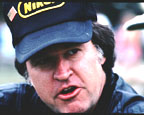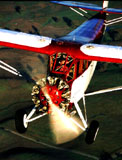 Grassroots
Grassroots

Time Check
Grassroots
Budd Davisson
Time Check
I hate it when this happens. I believe it's called a time check. Or maybe a reality check.
It was a postcard. One of those that used to cost a nickel (another time check?) but now run over two-bits. In a few short lines it referenced a past "Grassroots" and asked two questions about what I had said.
The card read, "What are glasspacks" and "What does 'check six' mean?"
The writer was serious as a heart attack and the card wasn't in crayon so it wasn't from a kid or an inmate. Or maybe it was from a kid. However, the term '"kid" seems to have a rolling definition attached that changes continually. Therein lies the problem.
The definition of kid seems to depend on a period of time that trails out behind each of us like an exhaust plume. Those in the closest, densest part of the plume talk the same language we do, like the same music, scoff at the same things. We share the same history, the same heroes and reference the same events that helped shape our lives.
As the plume of time trails out further behind, it thins out and the commonalty begins to disappear. Some of the likes overlap, some of the fears and understanding do too, but they are watered down by the intrusion of new ideas. New values. New segments of life that exist outside our own time plume because they happened at a time in our lives when our hearts and minds were otherwise occupied. They may have happened to all of us but a ten year old sees it differently than either a 20 year old or an old fogey of 40. Those of us way past that mark may not have even been aware it happened at all.
Increasingly, we find something happened to us only yesterday but we turn to find a lot of folks standing around the edge of our time-plume who weren't even born yet.
I guess the definition of "kid" is based on where that person falls in the time plume we claim as our own. They begin to look younger and younger, as they move back into the thinnest part.
It's hard to tell which identifies those at the back of the plume the fastest: Their youthful appearance or their words. Or their misunderstanding of words. Words like glasspacks, for instance.
In aviation we often think of airplanes the same way we think of people because the time track of people seems to parallel that of airplanes. At least it did until Wichita put a hiccup in it by ceasing to build flying machines.
One of the reasons we date pilots by their generation's airplanes is because different generations of pilots experience different generations of airplanes in totally different ways. They even experience the exact same airplane differently and often their words give them away.
Take the term "140" for instance. Depending where a person is in the pilot time continuum, it conjures up different images of the same airplane. Then it takes a real generation jump and the same term means different airplanes.
The 140 image in the mind of a pilot who learned to fly in the 40s and early 50s is that of a cute little metal bird that came out after the war and blew their generation's trainer, the Cub, into the weeds. In their mind's eye it is still a new airplane and a new concept.
To those who stepped into the cockpit in the 1960s, it's hard for them not to think of the 140 as simply a used airplane with a tailwheel. In those days the little airplane was lackluster, had no glamour and minimal value. It's hard for some to re-adjust the image.
Sometime around the late 70's or early 80's, the term "140" began to blur. Its definition became schizophrenic as different pilot generations began to use the same term to mean different airplanes.
Just for the record, a 140 is a Cessna. Not a Piper. But, then again, that's my generation talking.
Only kids talk about 140s and mean Pipers.
The same thing holds true with the term "180". A 172, however, is very definitely a 172 regardless of the generation.
If you think about it, the use of terms like 140 and the meaning attached to them can identify a pilot as belonging to a particular time frame, but it can also identify where he stands in the sport versus "normal" aviation thing. Hearing 140, a Spam can driver would normally envision Piper's low wing sledge hammer because the Cessna hasn't intruded on his world. The 140 (Cessna, not Piper), however, has been sucked so deeply into the world of sport aviation it has become an icon of classic aviation. The Piper version of the 140 doesn't even exist in the sport aviation glossary, even though it actually is old enough to qualify.
Those who remember 140s when new, have a difficult time understanding their current cult status. To them 140s are simply used airplanes. Nothing special.
To this generation of pilots, many of whom fit the "kid" definition, airplanes like 140s are nearly twice their age and a distant part of a history that exists only in coffee shop stories. 140's are curious, unique flying objects they can almost afford and which give tremendous fun. The airplanes predate their birth so, in their eyes, they are a part of distant history and fall into the same category as J-3s, C-3s and Jennies. And muskets. And sailing ships. Past history is past history.
But, glasspacks? Obviously we've flipped a few pages in a bunch of areas other than aviation. 57 Chevys were new, when I first got my license (both flying and driving) and I appreciate them, but I don't idolize them. I don't exactly see them as used cars, but I can't get behind the religion that has canonized them either. Now, '32 Fords, that's something else entirely. A deuce is a deuce is a deuce. Or is that another term that fell out the back of my time-plume along with glasspacks?
To all you "kids" out there (that's about 35 years and back), stop smirking and look back at the plume you're dragging behind you. Notice the young ones standing at the back? The ones with ear rings, dreadlocks and Sony's on their shoulders? Notice their smirks?
Your time is coming, kid.